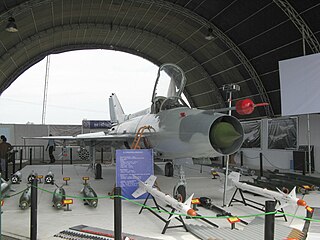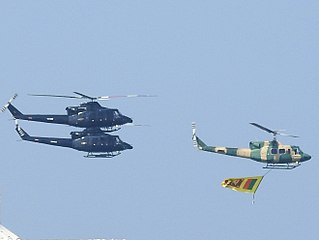| Sri Lanka Air Force |
|---|
 |
| Components |
| General Information |
| History |
| Aircraft |
| Leadership and ranks |
| Sri Lanka Air Force |
|---|
 |
| Components |
| General Information |
| History |
| Aircraft |
| Leadership and ranks |
In its early years, the air force was engaged primarily in immigration patrol, with occasional assistance in emergency relief. During the insurgency of 1971, the air force played a major role in restoring internal order; in addition to providing transport of ammunition, food, and troops, it participated in assaults against insurgent strongholds. Following the ethnic rioting of 1983, the air force was placed on permanent active status and participated in counter insurgency activities and airstrikes on the rebel controlled areas of the Northern and Eastern Provinces.
Because of a severe shortage of hard currency for military expenditures in the wake of the 1971 uprising, the Number Four Squadron(Helicopter) began operating commercial transportation services for foreign tourists under the name of Helitours. [1] In 1987 the air force had a total strength of 3,700 personnel, including active reserves. The force had grown gradually during its early years, reaching a little over 1,000 officers and recruits in the 1960s. Rapid growth began in the mid-1980s, when the Sri Lankan Civil War drew the service into a major, long-term security role. Between 1983 and 1987, the force grew by nearly 50 percent.
As in the other services, a shortage of spare parts plagued maintenance efforts, forcing the service to send a number of aircraft to Singapore and elsewhere for repairs. After the purchase of equipment from Canada in 1986, the air force gained the capability to make structural repairs on its fleet of Bell helicopters, several of which had been damaged in operations against the Tamil separatists. Maintenance of electronic equipment was performed at the communications station at Ekala, in the north of Colombo District.
The earliest aircraft were small transport airplanes and trainers, that were provided by the British and were supplemented in the late 1960s with United States Bell Helicopters.
In 1959 for the first time fighter jets were acquired, forming the No. 5 Jet Squadron; these were five BAC Jet Provost from the British. These were used in combat, when for the first time Sri Lanka Air Force went into combat during 1971 Insurrection. During insurgency, the left-leaning Bandaranaike government turned to the Soviet Union for more sophisticated weaponry, and received five MiG-17F fighter bombers, a MiG-15 UTI Midget trainer, and two Ka-26 helicopters. By the early 1980s, the Provosts and all of the Soviet aircraft had been taken out of active service and were relegated to long-term storage, leaving the air force without any bomber capability.



After the 1983 riots, the government worked rapidly to expand the inventory, relying largely on sources in Italy, Britain, and the United States. Because of tight budget constraints, the air force was compelled to refit a number of non combat aircraft for military uses in counter-terrorist operations against Tamil terrorists. From the period 1983 to 1985, the Air Force acquired 11 Bell 212 helicopters, 4 Bell 412 helicopters, 3 Siai Marchetti SF 260s, 2 Cessna 337s, 1 AVRO HS748 and 1 Beech King. By 1985, 9 more Bell 212s were added to the fleet, along with 4 Bell 412s. The 412s along with 3 Siai Marchetti SF 260 fixed-wing turbo prop aircraft advanced the attack capabilities of SLAF. Central in the government's security efforts were six SIAI Marchetti SF.260 turboprop which were used for rocket attacks and strafing. Additionally, the air force, with the help of Heli Orient of Singapore, equipped twelve Bell 212 and Bell 412 helicopters to serve as gunships and as transport vehicles for highly successful commando assault operations. The air force had a fleet of approximately eighty aircraft, of which sixty-four were reported to be operational in early 1988.
Government forces reportedly also used helicopters on bombing missions; frequently operating without conventional bombs, air force troops reportedly dropped hand grenades stuffed in wine glasses so that the lever would not be released until the glass shattered on the ground. A more effective bombing capability was provided by a small fleet of Chinese Harbin Y-12 turboprop transport aircraft. These were equipped with bomb racks that had been fitted to carry up to 1,000 kilograms of fragmentation and antipersonnel bombs. Transport, training, and surveying functions were carried out by a variety of Cessna and DeHavilland aircraft. In 1987 during the Vadamarachchi Operation the air force mustered 1 AVRO, 2 Y-12s and 1 Heron, all configured as improvised bombers. On 3 September 1987 a Women's Wing was formed and located in Colombo. The first CO was Air Cdre D.S.G. Vithana. The Women's Wing was set up to maintain and update all records pertaining to Lady Officers and Airwomen, prepare promotional schedules, annual assessments, issue identity cards, etc. [2]
In order to increase the attack capability the air force in 1991 acquired several F-7 Skybolts, FT-7s and Shenyang J-5s from China. Later in 1993 the first of 3 Mi-17 helicopter transports [3] were acquired along with four FMA IA 58 Pucarás for ground attack. These proved to be effective but three of the Pucara's were lost, two due to the SAMs launched by the LTTE. The sole remaining Pucara was retired in 1999 due to lack of spare parts. In 1995 Mi-24 gunships were acquired for close air support for the army and by 2001 Mi-35s were added to the fleet. [4]
In 1996 Sri Lankan Air Force acquired six Kfir C.2s and a single TC.2 from Israel [5] and further more nine aircraft had been added to the inventory by year 2005. This included four C.2s and four C.7s in 2001 . Currently the SLAF operates two TC.2s, two C.7s and eight C.2s. The SLAF is using these Kfirs to attack against Tamil separatist targets in rebel controlled areas of the island.
In 2000 new aircraft were acquired apart from the additions of Kfir C.7's & Mi-35s, these included six Mikoyan MiG-27 of ground attack, a MiG-23UB trainer and two C-130 Hercules for heavy transport. Six K-8 Karakorum trainers were soon added creating the No. 14 Squadron to train pilots for the newly expanded fleet of jets.
On 24 July 2001, Thirteen aircraft including two Kfir jet fighters, one MI-24 Helicopter gun ship and one MIG-27- jet fighter were destroyed in the predawn attack on the Katunayake air base, about 35 km. north of Colombo by the LTTE.Three military trainee planes and five civilian jets were also among the destroyed aircraft. TamilNet Much of these aircraft were replaced.
Sri Lanka's airport has remained on alert for a repeat of the 2001 attack, with severe restrictions on the number of people allowed into the terminal buildings. Huge walls were also built around the terminals and the control towers to prevent impact from car bomb attacks, while a large number of sentries were placed along the approach roads to the facility. All airports including the Katunayake International airport is guarded by members of the SLAF Regiment.

The Air Force of Zimbabwe (AFZ) is the air force of the Zimbabwe Defence Forces. It was known as the Rhodesian Air Force until 1980. The Air Force of Zimbabwe saw service in the Mozambican Civil War in 1985 and the Second Congo War of 1998–2001.

The Israel Aircraft Industries Kfir is an Israeli all-weather multirole combat aircraft based on the French Dassault Mirage 5, with Israeli avionics and an Israeli-built version of the General Electric J79 turbojet engine.

The SIAI-Marchetti SF.260 is an Italian light aircraft which has been commonly marketed as a military trainer and aerobatics aircraft.

The FMA IA 58 Pucará is an Argentine ground-attack and counter-insurgency (COIN) aircraft manufactured by the Fábrica Militar de Aviones. It is a low-wing twin-turboprop all-metal monoplane with retractable landing gear, capable of operating from unprepared strips when operationally required. The type saw action during the Falklands War and the Sri Lankan Civil War.
The Bandaranaike International Airport attack was a suicide raid Black Tigers of the Liberation Tigers of Tamil Eelam (LTTE) on 24 July 2001 on the Sri Lanka Air Force base SLAF Katunayake and the adjoining Bandaranaike International Airport in Katunayake, Sri Lanka. The attack was one of the boldest the LTTE mounted during its war with the Sri Lankan government, and had a profound impact on the country's military, economy, and airline industry.

The Sri Lanka Air Force is the air arm and the youngest of the Sri Lanka Armed Forces. It was founded in 1951 as the Royal Ceylon Air Force (RCyAF) with the assistance of the Royal Air Force (RAF). The SLAF played a major role throughout the Sri Lankan Civil War. The SLAF operates more than 160 aircraft.
The Tamil Eelam Air Force or Sky Tigers was the air service branch of the Divisions of the Liberation Tigers of Tamil Eelam, who used it against the Government of Sri Lanka. They also called themselves the Tamileelam Air Force (TAF). Though the existence of the Sky Tigers had been the subject of speculation for many years, the existence of the wing was only revealed after an attack in March 2007, during Eelam War IV.

No. 5 "Jet" Squadron is a squadron of the Sri Lanka Air Force. It currently operates in both air defence and ground attack role with F-7 Skybolts from SLAF Katunayake.

No. 2 "Heavy Transport" Squadron is a squadron of the Sri Lanka Air Force. It currently operates the C-130 Hercules and Antonov 32 from SLAF Katunayake.

No. 4 (VVIP/VIP) Helicopter Squadron is a squadron of the Sri Lanka Air Force. It currently operates Bell 412/412EP/212/206JR from SLAF Ratmalana for VVIP/VIP Air transport.

No. 1 Flying Training Wing currently based at SLAF China Bay, carries out basic pilot training of the Sri Lanka Air Force. It is the oldest flying formation in the SLAF.

The Sri Lanka Air Force Museum is the museum of the Sri Lanka Air Force, and its predecessor, the Royal Ceylon Air Force. Open to the public, the museum is at the SLAF Ratmalana and is maintained by the Sri Lanka Air Force.

Air Chief Marshal Harsha Abeywickrema, RWP, RSP, VSV, USP, rcds, psc, qfi is a senior Sri Lankan air force officer and fighter pilot, who served as the Commander of the Sri Lankan Air Force from 2012 to 2014 and later went on to serve as the Chairman of the Bank of Ceylon.
Operation Eagle was a Sri Lanka Air Force operation to resupply and rescue critically wounded service personnel from the old Dutch Fort of Jaffna held by the Sri Lanka Army and besieged by the LTTE on July 3, 1990. The successful rescue operation gained headlines, leading to much rejoicing island-wide and helped increase morale.

Air Chief Marshal Kolitha Gunathilake, RWP, RSP, VSV, USP, ndc, psc, qfi is a Sri Lankan fighter pilot and a former Chief of Defence Staff and Commander of the Sri Lankan Air Force.
Air Chief Marshal Dick Cuthbert Perera VSV was the 6th Commander of the Sri Lankan Air Force.
Air Chief Marshal Makalandage Johnny Terrence "Terry" De Silva Gunawardena, VSV (-2014) was the 8th Commander of the Sri Lankan Air Force.

A Sri Lanka Air Force Avro 748-357 Srs.2B SCD airliner was shot down on 29 April 1995 by a SA-7 missile fired by the Liberation Tigers of Tamil Eelam (LTTE), while it was on approach to land at SLAF Palaly from Ratmalana Airport. All 52 crew and passengers were killed.